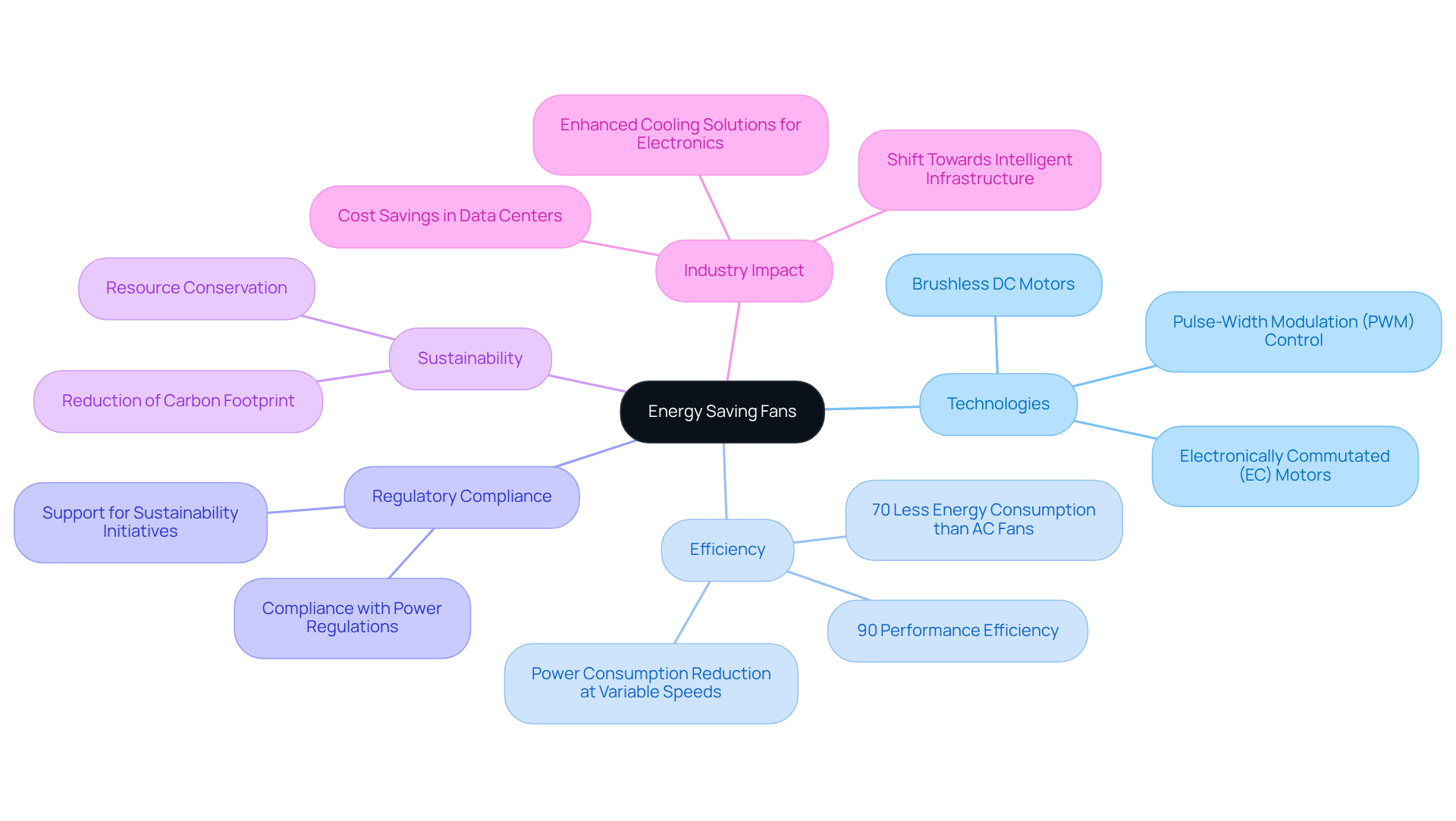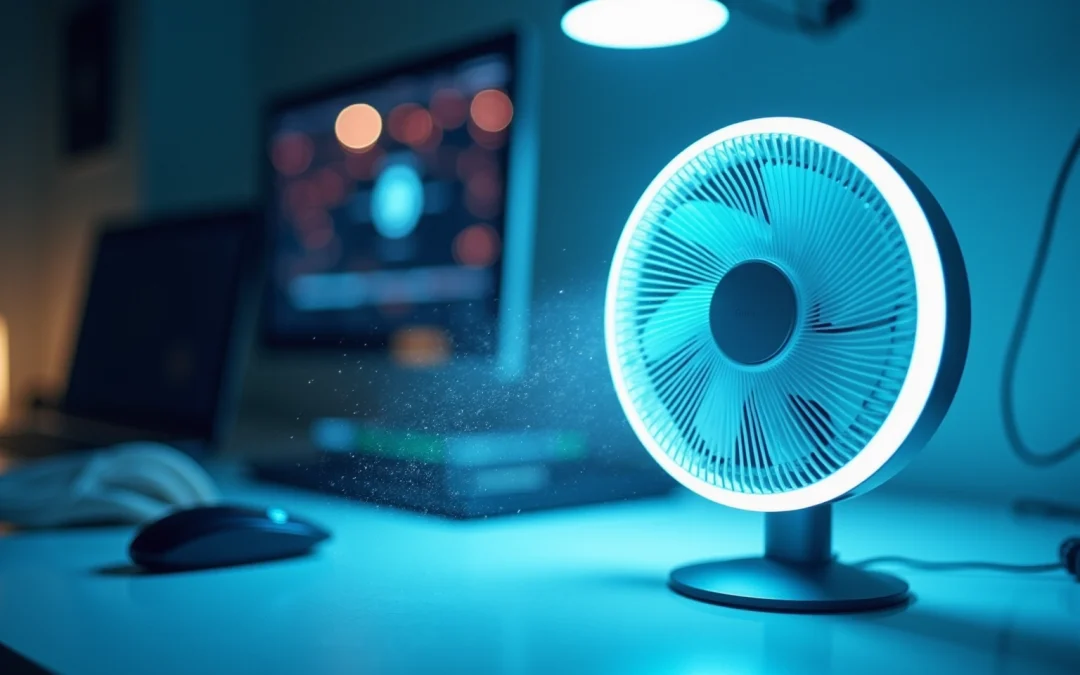Overview
The article examines the integration of energy-saving fans within electronic systems, aimed at enhancing overall efficiency and reducing operational costs. It asserts that these fans, which utilize advanced technologies such as brushless DC motors, can drastically decrease energy consumption—by as much as 70% compared to traditional models—while simultaneously improving thermal management and extending the lifespan of electronic components. This integration not only supports economic objectives but also aligns with environmental sustainability goals.
Introduction
The escalating demand for energy efficiency within the electronics sector has positioned energy-saving fans as a crucial element in contemporary system design. These advanced devices not only minimize power consumption but also optimize airflow, resulting in substantial operational cost savings and enhanced performance. Yet, with a multitude of options and specifications at hand, how can engineers adeptly integrate these fans to fully harness their advantages? This article explores the fundamental features, best practices, and transformative effects of energy-saving fans on system efficiency, offering a comprehensive roadmap for their successful implementation in electronic systems.
Define Energy Saving Fans and Their Importance in Electronics
, including the energy saving fan, are meticulously engineered to operate with significantly reduced power consumption while ensuring effective airflow. By leveraging such as brushless DC motors and , the energy saving fan devices achieve compared to traditional AC units. This level of efficiency is critical in the electronics sector, where minimizing waste directly translates to lower operational costs and improved system performance.
The integration of not only ensures compliance with stringent power regulations but also actively supports within the industry. , a global leader in power conversion products, offers a comprehensive range of , including both custom and standard DC units, as well as centrifugal blowers tailored for electronics applications.
The adoption of energy saving fans is increasingly vital as the electronics sector prioritizes in 2025, aligning with broader ecological goals and operational excellence. Furthermore, the implementation of pulse-width modulation (PWM) control can enhance power conservation, optimizing fan performance.
As Randall Scasny notes, “Electronically commutated (EC) blowers improve electronics cooling while utilizing considerably less power and, consequently, fostering resource conservation.” This observation underscores the industry’s broader shift towards , highlighting the significance of energy saving fans in contemporary electronic applications.

Explore Key Features and Specifications of Energy Saving Fans
When selecting energy-saving fans, it is crucial to prioritize several key features and specifications:
- Motor Type: Opt for or EC motors, renowned for their superior efficiency and quieter operation. Brushless DC motors, often used in energy saving fans, typically achieve a performance level of 85-90%, significantly surpassing conventional AC motors, which results in substantial energy savings. Gagner-Toomey Associates offers a comprehensive range of DC input tube axial units optimized for performance and efficiency, including models that vary from 15 to 280mm.
- Airflow Rate: Measured in cubic feet per minute (CFM), this metric indicates the volume of air the fan can move. For effective cooling, higher CFM ratings are essential; for example, a 48-inch ceiling fan consumes approximately 75 watts while delivering significant airflow, which is considerably less than air conditioning units that can consume between 500 to 3,500 watts. , available in sizes from 15 to 225mm, are engineered to provide suitable for various applications.
- : This factor plays a critical role in applications requiring airflow against resistance, such as in ducted systems. Understanding static pressure is vital for selecting devices that can maintain performance in challenging conditions. Gagner-Toomey’s solutions are specifically designed to meet these demands effectively.
- Noise Level: Measured in decibels (dB), are essential for preserving a comfortable atmosphere, particularly in residential settings. It is advisable to test fans with noise ratings prior to purchase to ensure they align with personal comfort levels. The low-noise operation of Gagner-Toomey’s devices significantly enhances user experience in sensitive environments.
- : Seek devices that carry , indicating compliance with stringent efficiency standards. ENERGY STAR certified models, like the energy saving fan, can consume up to 60% less power than traditional alternatives, making them a prudent choice for cost savings. Gagner-Toomey Associates is dedicated to providing that comply with these standards.
- : Features such as variable speed control and smart technology integration enhance resource savings and operational flexibility. Intelligent devices can adjust according to temperature and occupancy, potentially reducing expenses by 4 to 11%. Gagner-Toomey’s integrated cooling solutions provide advanced control options for optimal performance.
By concentrating on these specifications, engineers can select devices that not only fulfill performance requirements but also lead to substantial energy savings and improved environmental impacts by utilizing the innovative energy saving fan solutions offered by Gagner-Toomey Associates.

Implement Energy Saving Fans in Electronic Systems: Best Practices
To effectively implement energy-saving fans in electronic systems, it is essential to adhere to the following best practices:
- Conduct a System Analysis: Begin by evaluating the of your system to identify the appropriate fan size and type. This foundational step ensures that the chosen units can fulfill the specific airflow and pressure requirements of your application.
- : Strategically place air circulators to maximize airflow and minimize resistance. Avoid hindrances from other components, as incorrect positioning can lead to significant performance declines, increasing and diminishing cooling effectiveness. Notably, statistics indicate that energy saving fans account for 35% of the power usage in Air Conditioning and Mechanical Ventilation (ACMV) systems, underscoring the importance of proper positioning for cost savings.
- Utilize : Implement controls that adjust fan speed based on real-time temperature or load conditions. This approach not only enhances energy conservation but also extends the lifespan of the devices by incorporating an energy saving fan that reduces unnecessary wear.
- : Schedule routine upkeep to clean and inspect ventilation systems. Regular maintenance, including damage inspections, ensures that the energy saving fan operates at maximum performance, which is crucial for maintaining optimal temperatures in electronic devices. Establishing a proactive maintenance timetable can further enhance efficiency and mitigate safety hazards associated with poorly maintained units.
- : Employ sensors and tracking tools to observe fan performance and power usage. This data facilitates timely adjustments, ensuring that fans operate efficiently and effectively.
- Combine with HVAC Networks: If applicable, to improve overall power usage and comfort levels. This integration can yield substantial resource savings, as demonstrated by case studies revealing enhanced performance in healthcare facilities through systematic resource conservation programs. For instance, an upper Midwest hospital achieved considerable resource savings by implementing efficiency strategies that reduced testing and control duration for their boiler setup by 80%, resulting in labor cost reductions of $10,940 and a decrease in greenhouse gas emissions by 104 metric tons annually.
By adhering to these best practices, engineers can significantly enhance the performance and reliability of electronic devices while achieving substantial energy savings through the use of an energy saving fan. As Jeff Smoot, a mechanical engineering specialist, aptly states, ‘Understanding the complexities of fan technology is crucial for enhancing performance in electronic devices.

Analyze the Impact of Energy Saving Fans on System Efficiency and Cost Savings
Incorporating into electronic systems significantly enhances efficiency and yields . The key impacts include:
- Reduced : Energy-saving fans can consume up to 70% less power than traditional models, resulting in lower electricity bills. ENERGY STAR® certified ceiling devices are up to 60% more efficient than their conventional counterparts, making them a prudent choice for energy-conscious consumers. This reduction is particularly advantageous in environments where cooling is critical, as account for nearly 12% of total residential power consumption in the U.S.
- Extended Equipment Lifespan: By maintaining optimal operating temperatures, these fans contribute to prolonging the lifespan of electronic components, which can lead to decreased replacement costs. Effective is essential in preventing overheating, ensuring the reliable operation of sensitive equipment.
- : Enhanced airflow from energy-efficient units facilitates superior thermal management, which is vital for maintaining system reliability. For instance, one household in Oregon reported a 40% reduction in their summer cooling expenses after installing energy-efficient ceiling devices, illustrating the tangible benefits of improved airflow. Furthermore, occupants can without compromising comfort, resulting in additional cost savings.
- Lower Maintenance Costs: Energy-efficient devices generally require less maintenance due to their advanced design and materials, further lowering operational expenses. Routine upkeep, including blade cleaning and motor lubrication, remains crucial for optimizing performance and durability.
- : By reducing energy consumption, these devices help decrease greenhouse gas emissions, aligning with sustainability goals in the electronics sector. The adoption of energy-efficient technologies not only fosters cost savings but also promotes a more sustainable future, making them an appealing option for engineers and businesses alike.
In summary, the integration of not only enhances system efficiency but also results in significant financial and environmental advantages, establishing them as a sound investment for the electronics sector.

Conclusion
The integration of energy-saving fans into electronic systems represents not merely a technological advancement; it stands as a pivotal strategy for enhancing efficiency and reducing operational costs. These fans are meticulously designed to operate with minimal power consumption while delivering optimal airflow, making them essential in addressing the rising demands for sustainability and compliance within the electronics sector. By adopting energy-saving fans, organizations can significantly lower their energy expenditures and support environmental initiatives, positioning themselves for a wise investment in the future.
Key insights from this exploration underscore the critical importance of:
- Selecting the appropriate motor types
- Comprehending airflow rates
- Implementing effective control options to maximize performance
Best practices, including:
- Conducting thorough system analyses
- Optimizing airflow positioning
- Ensuring regular maintenance
are paramount for leveraging the full potential of energy-saving fans. The tangible benefits—ranging from decreased energy consumption and extended equipment lifespan to improved system performance—underscore the transformative impact these devices can exert on both financial and environmental fronts.
Ultimately, the shift towards energy-saving fans reflects a broader commitment to sustainability and operational excellence within the electronics industry. As the sector continues to evolve, embracing these advanced technologies will not only yield significant cost savings but also contribute to a more sustainable future. Engineers and decision-makers are strongly encouraged to prioritize the integration of energy-saving fans within their systems, harnessing the advantages of enhanced efficiency and resource conservation for a greener tomorrow.
Frequently Asked Questions
What are energy saving fans?
Energy saving fans are devices designed to operate with significantly reduced power consumption while providing effective airflow. They utilize advanced technologies such as brushless DC motors and electronically commutated (EC) motors to achieve high performance efficiencies.
How efficient are energy saving fans compared to traditional AC units?
Energy saving fans can achieve performance efficiencies of up to 90% compared to traditional AC units.
Why are energy saving fans important in the electronics sector?
They are important because they minimize waste, which leads to lower operational costs and improved system performance. Additionally, they help ensure compliance with power regulations and support sustainability initiatives.
What company offers a range of cooling solutions that includes energy saving fans?
Gagner-Toomey Associates is a global leader in power conversion products that offers a comprehensive range of cooling solutions, including custom and standard DC units and centrifugal blowers tailored for electronics applications.
What is the significance of adopting energy saving fans by 2025?
The adoption of energy saving fans is increasingly vital as the electronics sector prioritizes power conservation, aligning with broader ecological goals and operational excellence.
How can pulse-width modulation (PWM) control enhance the performance of energy saving fans?
PWM control can enhance power conservation by optimizing the performance of the fans, leading to more efficient operation.
What is the industry trend regarding energy saving fans and resource conservation?
The industry is shifting towards intelligent infrastructure, with energy saving fans playing a significant role in improving electronics cooling while utilizing considerably less power, thus fostering resource conservation.

